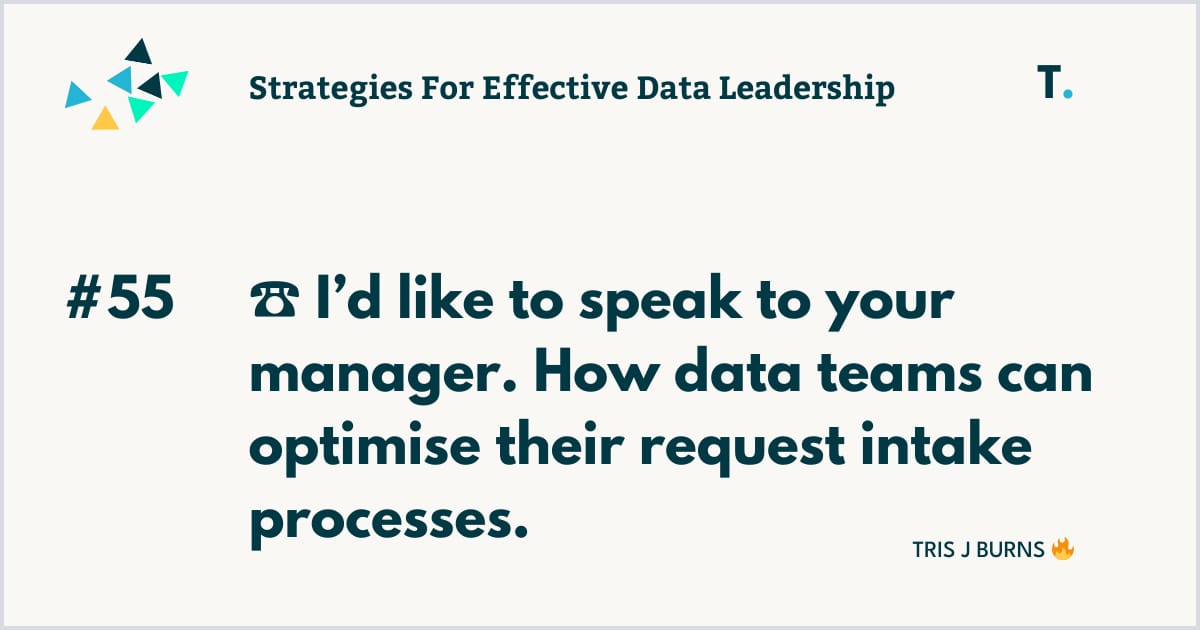
READ TIME: [5] MINUTES
Shovelling snow in a blizzard…
Very excited to announce the launch of the Bad Ass Bookshelf in February!
The book club for Bad Asses on an epic journey of self development and business success!
The Bad Ass Bookshelf is for lovers of business, management and personal development books.
Each month the Bad Ass Bookshelf community will select a book for the coming month via a vote inside our emails. Then each week, we’ll share insights and learnings from the book as we progress through it together.
At the end of the month we will host a video call for members of the Bad Ass Bookshelf community to get together and discuss that month’s book - just like an IRL book club, but with cooler people (aka you and me).
It’s free to join, so check it out here:
That’s how I’d describe the state of play for a lot of data teams out there.
Many teams operate informal and ad hoc intake processes. Work can be submitted and requested of the team by business stakeholders in any number of ways, including:
Email
Slack
Teams IM
WhatsApp
Verbally in meetings
Whispered upon a gentle breeze
These kinds of requests are usually prefixed by, comments like “It’ll just take a min”, or “I need it by sundown”, or “You data guys really are rockstars”.
These kinds of requests are usually prefixed by, comments like “It’ll just take a min”, or “I need it by sundown”, or “You data guys are rockstars!”.
In many organisations, data teams struggle to handle high volumes of requests effectively. Whether it’s urgent queries, project support, or strategic analysis, stakeholders often expect immediate responses, leaving data teams stretched thin and reactive.
This challenge becomes even more pronounced when requests come through informal channels like the ones listed above.

Live footage of data team handling requests
Without a structured process, data teams face constant interruptions, making it very difficult to prioritise high-value, strategic work. They risk losing track of requests, providing inconsistent service, and missing opportunities to deliver strategic value to the organisation - No bueno.
Unfortunately, when data teams don’t operate with a formalised intake system, several negative impacts arise, which we’ll explore below 👇🏻
Do your data teams operate a formalised intake process?
(Remember to check out the results from the last poll - results down below👇🏻)
😬 The bad part
📉 Impact #1: Reduced productivity
Handling requests informally often means data teams must stop what they are doing to gather clarifications in real time. This disrupts focus, leads to inefficiencies, and leaves little time for proactive or strategic work.
📋 Impact #2: Poor prioritisation
Ad hoc requests make it challenging to assess and prioritise tasks based on business value. As a result, urgent but low-impact work can overshadow projects with significant strategic potential.
🤷🏽♀️ Impact #3: Inconsistent stakeholder experiences
Without a standardised approach, stakeholders receive varying levels of service depending on who they interact with and how. This inconsistency can erode trust in the data team and result in stakeholders leaning on certain team members in particular.
🧩 Impact #4: Lack of visibility and data
Informal processes make it difficult to track request volumes, completion rates, and types of work. This lack of data hinders efforts to measure team efficiency and identify trends in stakeholder needs. It’s also makes it more challenging to create businesses cases for increasing team resources such as head count and L&D budgets.
🤬 Impact #5: Stakeholder frustration
When expectations are not managed effectively, stakeholders can grow frustrated with delays, unclear timelines, or perceived inaction. This undermines the relationship between data teams and the wider organisation.
The good news is that these challenges can be overcome with a systemised intake process for data requests. This approach benefits both data teams and stakeholders by bringing clarity, efficiency, and strategic focus to how work is requested and delivered.
Let’s take a look at that below 👇🏻
🛠️ The fix-it part
The key to resolving these problems in my view is to implement a formalised intake system that standardises how requests are submitted, tracked, and prioritised. This allows data teams to take control of their workload, ensuring that they deliver the most valuable outcomes for the business.
(Important note: it doesn’t matter what system you use so long as you can collect, catalogue and report data consistently)
To get started:
✍🏻 Define a clear intake process
Create a system where all requests are submitted through a single platform, such as a ticketing tool or a custom-built form. At a minimum, the system should capture essential information like the requestor’s details, the purpose of the request, and the desired outcome. This ensures that all requests provide sufficient context upfront, reducing the need for back-and-forth clarifications.🙋🏼♂️ Standardise stakeholder questions
Develop a set of standardised questions that stakeholders must answer when submitting requests. For example: “What business problem are you trying to solve?” or “How will this analysis support your goals?” This step helps stakeholders refine their asks, ensures alignment with strategic objectives, and establishes a solid foundation for meaningful collaboration. It also brings the data team close to business challenges and puts them in a position to spot peripheral opportunities.📋 Introduce prioritisation criteria
Define clear criteria for evaluating and prioritising requests. For example, consider factors like expected business impact, alignment with organisational strategic goals, and level of effort required. This approach enables the data team to focus on high-value work and communicate their priorities transparently.🤝 Set expectations with stakeholders
Establish a Service Level Agreement (SLA) that outlines response times and other expectations. For instance, you might commit to triaging all requests within 72 hours (or less, calm down). This doesn’t guarantee immediate delivery but signals that the team has a structured process and respects stakeholder needs.🧭 Monitor and refine the process
Continuously collect data on request volumes, completion times, and stakeholder satisfaction. Use these insights to identify bottlenecks, improve workflows, and ensure that the process evolves to meet organisational needs.
💪🏻 An unexpected benefit
The real beauty of a consistent and formalised system is the data collection component. We are data people after all, so being able to collect and analyse data on the types, urgency and volume of requests we receive should be a top priority for leaders.
Say for example you’ve had a system in place now for a full quarter. You’ll now be in a position to report back to the business on how the team has performed over the 3 months while the system has been in place.
You’ll know what kinds of requests you’re getting, what your completion rate looks like, who the main areas of the business that rely on your team are etc. You’ll be in an excellent position to know whether or not the currently team structure and size is sufficiently supporting the business, or if changes such as more investment are needed.
If you’re sceptical about implementing a systemised process, give it a go for a few months with some of these benefits in mind and I’m sure you’ll see the light. ✨
🌟 DIY Coaching For Data Careers 🌟
If you’re interested in data leadership coaching, but not yet ready to commit to the full fat version, then my DIY Coaching could be for you.
DIY Coaching helps data professionals unlock and maximise the potential of their data careers in their own time and at their own speed.
This self-paced email series and accompanying exercises provides actionable tools to help data professionals navigate career transitions, set goals, and achieve success.
It’s currently only £49
To learn more about this hugely popular product and to purchase, click here!
⚡️ Previous poll results
Last time, we talked about the difference between strategies and tactics. If you missed it you’re new around here, you can find it here!
In last week’s quiz I asked you how do you rate your own level of strategic literacy, and this is how you responded 👇🏻
Looks like quite the mix bag!


Tristan Burns
💡 Helpful resources for data professionals:
The Data Leadership Frameworks: This email series containing 10 data leadership frameworks, will equip you with the necessary skills and knowledge to maximise your effectiveness and become the influential and powerful data leader you know you can be.
DIY Coaching Program: Through a series of 9 self-guided exercises, you’ll clarify your goals, overcome obstacles, and create a plan for your next career move - all at your own pace.
⚡️Three more ways I can help you:
Private Coaching for Data Leaders: I work with data professionals looking to grow into influential and unstoppable data leaders to help them navigate and overcome the challenges of being a data leader.
Group coaching for Data Teams: Great data teams can make or break businesses. Through my facilitated 6-week group coaching program, together we get to the heart of what is holding teams back and set a course for data-driven success.
Google Analytics, Tagging and Looker Support: Helping teams to set up or optimising their data eco system, generate actionable insights and gain more in-depth knowledge through training.
What did you think of this email?
If you enjoyed this newsletter, why not forward it to a friend.
Did someone forward you this email? You can subscribe to Strategies for Effective Data Leaders here!



